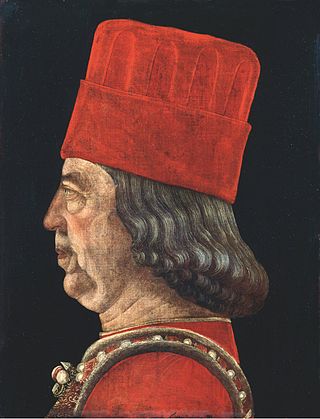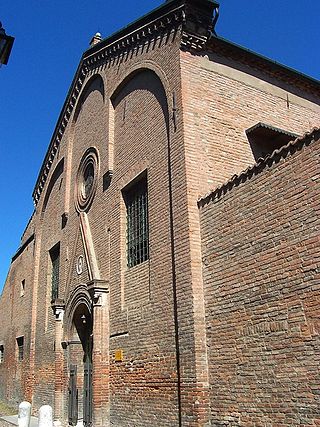
Bradamante d'Este, Countess of Maccastorna (1550 - 1624, Ferrara) was an Italian noblewoman from the House of Este.

Bradamante d'Este, Countess of Maccastorna (1550 - 1624, Ferrara) was an Italian noblewoman from the House of Este.
She and her elder sister Marfisa were illegitimate daughters of Francesco d'Este, though were legitimated a few years after their birth by both pope Gregory XIII and by Alfonso II d'Este. In 1575 Bradamante married Ercole Bevilacqua, Count of Maccastorna, privy councillor and state and military advisor to Alfonso II d'Este, Duke of Ferrara. In 1590 her husband had to leave Ferrara after Ercole Trotti discovered Bevilacqua's affair with Trotti's wife Anna Guarini, a court singer. Bradamante remained in Ferrara while her husband settled in Sassuolo. He only returned to Ferrara in 1598 after Alfonso's death and Ferrara's incorporation into the Papal States, [1] thanks to intercession from cardinal Bonifazio Bevilacqua Aldobrandini, a relation.
Bradamante and Ercole had twelve children:

The House of Este is a European dynasty of North Italian origin whose members ruled parts of Italy and Germany for many centuries.

The Duchy of Modena and Reggio was an Italian state created in 1452 located in Northwestern Italy, in the present day region of Emilia-Romagna. It was ruled since its establishment by the noble House of Este, and from 1814 by the Austria-Este branch of the family. The Este dynasty was a great sponsor of the arts, making the Duchy a cultural reference during the Renaissance and Baroque periods.
Anna Guarini, Contessa Trotti was an Italian virtuoso singer of the late Renaissance. She was one of the most renowned singers of the age, and was one of the four concerto di donne at the Ferrara court of the d'Este family, for whom many composers wrote in a progressive style.

This is a list of rulers of the estates owned by the Este family, which main line of Marquesses rose in 1039 with Albert Azzo II, Margrave of Milan. The name "Este" is related to the city where the family came from, Este.
The School of Ferrara was a group of painters which flourished in the Duchy of Ferrara during the Renaissance. Ferrara was ruled by the Este family, well known for its patronage of the arts. Patronage was extended with the ascent of Ercole d'Este I in 1470, and the family continued in power till Alfonso II, Ercole's great-grandson, died without an heir in 1597. The duchy was then occupied in succession by Papal and Austrian forces. The school evolved styles of painting that appeared to blend influences from Mantua, Venice, Lombardy, Bologna, and Florence.

The Duchy of Ferrara was a state in what is now northern Italy. It consisted of about 1,100 km2 south of the lower Po River, stretching to the valley of the lower Reno River, including the city of Ferrara. The territory that was part of the Duchy was ruled by the House of Este from 1146 to 1597.

Borso d'Este was the duke of Ferrara the first duke of Modena, which he ruled from 1450 until his death. He was a member of the House of Este.
Azzo X d'Este (1344–1415) was an Italian condottiero, a member of the House of Este.

Ercole I d'Este KG was Duke of Ferrara from 1471 until 1505. He was a member of the House of Este. He was nicknamed North Wind and The Diamond.

Alfonso IV d'Este was Duke of Modena and Reggio from 1658 until his death. He was the father of Mary of Modena, consort of James II of England.
Giulio d'Este was the illegitimate son of Ercole I d'Este, Duke of Ferrara. He is known for the conflicts he had with his half brother, Ippolito d'Este, which culminated in a failed conspiracy.

Maria Teresa Cybo-Malaspina was sovereign Duchess of Massa and Princess of Carrara from 1731 until her death in 1790. From 1780, she also formally held the title of Duchess consort of Modena and Reggio as the wife of Ercole III d'Este.

The Galleria Estense is an art gallery in the heart of Modena, centred around the collection of the d’Este family: rulers of Modena, Reggio and Ferrara from 1289 to 1796. Located on the top floor of the Palazzo dei Musei, on the St. Augustine square, the museum showcases a vast array of works ranging from fresco and oil painting to marble, polychrome and terracotta sculpture; musical instruments; numismatics; curios and decorative antiques.

Lucrezia d'Este was an Italian noblewoman. By birth she was a member of the House of Este, and by marriage to Francesco Maria II della Rovere, Duke of Urbino she was Duchess consort of Urbino and Sora, and Lady consort of Pesaro, Senigallia, Fossombrone and Gubbio.

The Corpus Domini Monastery is a monastery at 4 via Pergolato in Ferrara. It first was founded as a house of penitent women, and became a Poor Clares Observant Franciscan convent in 1431. It was the home of Caterina Vigri from 1431 to 1456. She served as the mistress of novices, teaching about 100 women to become pious nuns. She was also an artist who illuminated her own breviary and is said to have decorated the walls of the convent with images of the Christ Child. These were lost or destroyed in a fire in 1667. The public church was redecorated in the late-Baroque period. On its high altar is Communion of the Apostles by Giambettino Cignaroli (1768), whilst the church's ceiling fresco Glory of Saint Catherina Vegri is by Giuseppe Ghedini (1770–1773). The house is still a monastery; a community of Franciscan nuns, called Poor Clares after S. Clare their founder and companion to S. Francis. One of their abbesses was the daughter of Lucrezia Borgia, Leonara d'Este. She is now recognised as one of the earliest writers of polyphonic choral music for women.

Ferrante d'Este was a Ferrarese nobleman and condottiero. He was the son of Ercole I d'Este and Eleonora d'Aragona - he was named after his mother's father Ferdinand I of Naples. His five siblings were Alfonso I d'Este, cardinal Ippolito d'Este, Isabella d'Este, wife of Francesco II Gonzaga, Beatrice d'Este, and Sigismondo d'Este. His two illegitimate half-siblings were Giulio and Lucrezia d'Este.

Marfisa d'Este was a Ferrarese noblewoman. She was the illegitimate daughter of Francesco d'Este and Maria Folch de Cardona. She and her sister Bradamante were legitimised by both pope Gregory XIII and Alfonso II d'Este. She was also notable as a patron of the arts and the protector of Torquato Tasso.
Francesco d'Este, Marchese de Massa Lombarda was an Italian nobleman from the House of Este. He was the eighth child and fifth son of Alfonso I d'Este and his second wife Lucrezia Borgia.
Ercole Bevilacqua, Count of Maccastorna was an Italian nobleman, soldier and statesman.
Alderano Cybo-Malaspina was an Italian nobleman. He was marquess of Carrara, count of Ferentillo, first Duke of Ferentillo from 1603, Roman Patrician and Genoese Patrician, Patrician of Pisa and Florence, Patrician of Naples and Noble of Viterbo.